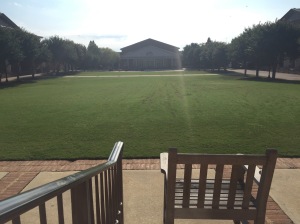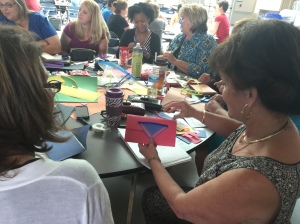As I eased myself into the teak rocking chair, I heard a creak. I think it was the chair, but it could have easily been by knees, or my back, or my neck. I lifted the glass lemonade to my lips as I rocked gently back and forth. I was sitting outside the Cary Academy library, looking down the Quad. Beautiful. The smell of newly trimmed grass and the peacefulness of the scene made me happy. A butterfly floated past, the nearest thing to an interruption of the bliss.
It was the evening before school started. And it was calm, and peaceful, and quiet.
By the next morning it could have been another lifetime. The first day of school brought kids, and booming voices, and kids, and muddy shoes, and more kids. Each one tracking dirt into the buildings … and walking … All. Over. Our. Lawn.
Let me start over.
I haven’t been myself over the past few weeks. I’m feeling a bit grumpy as we start the 2015-2016 school year. Some recent headlines have me acutely feeling the passage of time.
You may have heard the news, too. LOL is dead.
After analyzing posts for a seven-day period, Facebook said that the most common form of online laughter during my youth, LOL (Laugh Out Loud), was dead. It has been replaced by haha or hehe (50% + of users) or an emoji (35%). Fewer than 2% of us still use LOL.
I was in high school in the mid-1980s when LOL first came into existence, part of the first online chat rooms. When texting began, pre-smartphone era, I remember the fun that was had when parents, wanting to be hip but demonstrating their cluelessness, tried to use LOL as a stand in for Lots Of Love. This lead to wonderful texts like: “Dear son, you are kind, and good, and talented. LOL. Mom.”
After almost 20 years working its way from chatrooms to text messages, LOL finally hit the big time in 2011 when it made it into the Oxford English Dictionary. Four years later, gone.
That’s got me feeling my age. And I’m not the only one.
Earlier this summer, I came up to the quad to celebrate with the class of 2005 at their 10-year reunion. They wanted to know what had changed at CA. I talked about how classroom and collaboration work has evolved with the use of laptops, the cloud, Haiku, Veracross, and OneNote. Whoa, whoa, they said. Laptops? Seems like a whole lot has changed since they worked on desktops tethered to tables by lots and lots of wires.
When I shared these observations with our upper school students during convocation, I suspect that many of them put them down to the rantings of a typical out-of-touch old person, somebody who still doesn’t get Snapchat. Like really doesn’t get it.
I guess that’s the point, I told them. My mom didn’t get LOL. She just got her first smartphone this summer. Now LOL is gone, a word lost before its time. Will our current students look back in 10 years and laugh at the way they used to communicate by sending pictures, hundreds and hundreds and hundreds of pictures. All. Day. Long.
Like I said, I don’t get Snapchat.
Change is really the point, though.
According to the most recent Shift Happens video originally created by Karl Fisch and updated by Scott McLeod (and seen more than 10 million times online), the Department of Labor says that an average adolescent today will have 38 jobs in his or her lifetime. For those in elementary school, 65% could have jobs that don’t even exist yet.
How do schools that were conceived to prepare students for an industrial age cope?
Well, we hope that we prepare students to think.
During the convocation, Upper School Principal Heather Clarkson shared some very important perspectives about how we go about this task. Stanford professor Carol Dweck argues the crucial starting point is believing that we can constantly learn and grow.
During a powerful moment of her talk, Ms. Clarkson asked students to close their eyes and reflect on a personal goal for the year. She asked them, eyes still closed, to raise their hands if their goal was about good grades or doing well on a test. She then asked for hands up if a main goal was about a personal challenge to learn or do something new.
I don’t have to tell you what it looked like in the auditorium during that exchange.
Ms. Clarkson then challenged students to consider that the purpose of school is more than just passing somebody else’s test of their worth. We cannot avoid assessments, but we should not be driven or defined by them. We must embrace our capacity to learn and grow throughout life. As Ms. Clarkson aptly tells students: “Own your learning.”
Several others have been challenging us to see things differently for quite a while. Educator Grant Wiggins, writing in Education Leadership more than 20 years ago, said “the aim of curriculum is to ‘awaken’ not ‘stock’ or ‘train’ the mind.” Just this past week, the New York Times op-ed section ran a provocative piece on the importance of teaching ignorance.
The recently approved Cary Academy Strategic Plan contains language that challenges us to think about the ways in which education is changing. It challenges us to think about how we use space, how we organize curriculum, and how we help prepare students for an uncertain future.
If Google, a company seemingly on top of the world, feels a need to change — announcing recently the creation of a new organizational structure and parent company called Alphabet — I suspect that change is coming for us all.
Hey, maybe Alphabet can help bring back my beloved LOL.


